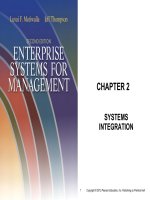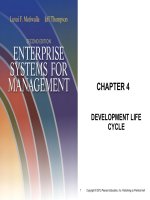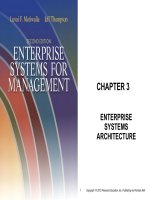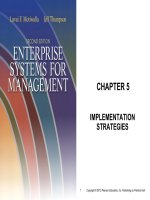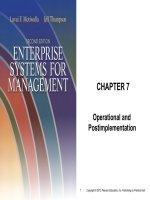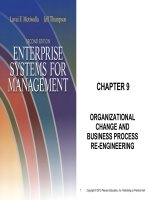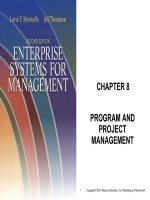Principles of operations management 9th by heizer and render chapter 05s
Bạn đang xem bản rút gọn của tài liệu. Xem và tải ngay bản đầy đủ của tài liệu tại đây (674.73 KB, 38 trang )
5
SUPPLEMENT
Sustainability in
the Supply Chain
PowerPoint presentation to accompany
Heizer and Render
Operations Management, Eleventh Edition
Principles of Operations Management, Ninth Edition
PowerPoint slides by Jeff Heyl
© 2014
© 2014
Pearson
Pearson
Education,
Education,
Inc.Inc.
S5 - 1
Outline
►
►
►
►
Corporate Social Responsibility
Sustainability
Design and Production for
Sustainability
Regulations and Industry Standards
© 2014 Pearson Education, Inc.
S5 - 2
Learning Objectives
When you complete this chapter you
should be able to :
1. Describe corporate social responsibility
2. Describe sustainability
3. Explain the 3Rs for sustainability
4. Calculate design for disassembly
5. Explain the impact of sustainable
regulations on operations
© 2014 Pearson Education, Inc.
S5 - 3
Corporate Social
Responsibility
▶ How products and services affect people
and the environment
▶ Stakeholders have strong opinions about
environmental, social, and ethical issues
▶ Doing what’s right can be beneficial to all
stakeholders
▶ Corporate social responsibility (CSR)
© 2014 Pearson Education, Inc.
S5 - 4
Sustainability
▶ Meeting the needs of the present without
compromising the ability of future
generations to meet their needs
▶ More than “going green”
▶ Includes employees, customers,
community, and company reputation
© 2014 Pearson Education, Inc.
S5 - 5
Systems View
▶ Looking at a product’s life from design to
disposal, including all the resources
required
▶ The product or service itself is a small
part of much larger social, economic, and
environmental systems
▶ Understanding systems allows more
informed judgments regarding
sustainability
© 2014 Pearson Education, Inc.
S5 - 6
Commons
▶ Inputs to a production system held by
the public
▶ Common resources often misallocated
▶ Possible solutions include
1) Moving some of the common to private
property
2) Allocation of rights
3) Regulation
© 2014 Pearson Education, Inc.
S5 - 7
Triple Bottom Line
▶ Consider the systems necessary to
support the three Ps: people, planet, and
profit
Figure S5.1
© 2014 Pearson Education, Inc.
S5 - 8
Triple Bottom Line
▶ Decisions affect people
▶ Globalization and outsourcing complicate
the task
▶ Supplier selection and performance
criteria are important
▶ Materials must be safe and
environmentally responsible
© 2014 Pearson Education, Inc.
S5 - 9
Walmart’s Objectives
▶ Improving livelihoods through the creation
of productive, healthy, and safe
workplaces
▶ Building strong communities through
access to affordable, high-quality services
▶ Preventing exposure to substances that
are considered harmful or toxic
▶ Promoting health and wellness
© 2014 Pearson Education, Inc.
S5 - 10
Triple Bottom Line
▶ The planet’s environment
▶ Look for ways to reduce the
environmental impact of operations
▶ Overarching objective is to conserve
scarce resources
▶ Carbon footprint and greenhouse gas
emissions (GHG)
© 2014 Pearson Education, Inc.
S5 - 11
Carbon Footprint
Figure S5.2
34.5-gram Bag of
Frito-Lay Chips
© 2014 Pearson Education, Inc.
S5 - 12
Triple Bottom Line
▶ Social and environmental sustainability
do not exist without economic
sustainability
▶ Staying in business requires making a
profit
▶ Alternate measures of success include
risk profile, intellectual property,
employee morale, and company
valuation
▶ Social accounting
© 2014 Pearson Education, Inc.
S5 - 13
Design and Production for
Sustainability
▶ Life cycle assessment valuates the
environmental impact of a product, from raw
material and energy inputs all the way to the
disposal of the product at its end-of-life
▶ The goal is to make decisions that help
reduce the environmental impact of a product
throughout its entire life
▶ The 3Rs— reduce, reuse, and recycle
© 2014 Pearson Education, Inc.
S5 - 14
Product Design
▶ Design decisions affect materials, quality,
cost, processes, related packaging and
logistics, and how the product will be
processed when discarded
▶ Incorporate systems view to lower
environmental impact
▶ Alternative materials
© 2014 Pearson Education, Inc.
S5 - 15
Design for Disassembly
Harmonizer
PART
Printed circuit board
RESALE
REVENUE
PER UNIT
RECYCLING
REVENUE
PER UNIT
PROCESSING
COST
PER UNIT
DISPOSAL
COST
PER UNIT
$5.93
$1.45
$3.46
$0.00
Laminate back
0.00
0.00
4.53
1.74
Coil
8.56
5.65
6.22
0.00
Processor
9.17
2.65
3.12
0.00
Frame
0.00
0.00
2.02
1.23
11.83
2.10
2.98
0.00
$35.49
$11.94
$22.33
$2.97
Aluminum case
Total
© 2014 Pearson Education, Inc.
S5 - 16
Design for Disassembly
Rocker
PART
Printed circuit board
RESALE
REVENUE
PER UNIT
RECYCLING
REVENUE
PER UNIT
PROCESSING
COST
PER UNIT
DISPOSAL
COST
PER UNIT
$7.88
$3.54
$2.12
$0.00
Coil
6.67
4.56
3.32
0.00
Frame
0.00
0.00
4.87
1.97
Processor
8.45
4.65
3.43
0.00
Plastic case
0.00
0.00
4.65
3.98
$23.00
$12.75
$18.39
$5.95
Total
© 2014 Pearson Education, Inc.
S5 - 17
Design for Disassembly
Revenue
retrieval =
Total
Total
Total
Total
resale + recycling – processing – disposal
revenue
revenue
cost
cost
Revenue
retrieval for
Harmonizer
= $35.49 + $11.94 – $22.33 – $2.97 = $22.13
Revenue
retrieval for
Rocker
= $23.00 + $12.75 – $18.39 – $5.95 = $11.41
© 2014 Pearson Education, Inc.
S5 - 18
Production Process
▶ Reduce the amount of resources in the
production process
▶ Energy
▶ Water
▶ Environmental contamination
▶ Reduce cost and environmental
concerns
© 2014 Pearson Education, Inc.
S5 - 19
Logistics
▶ Reduce costs by achieving efficient
route and delivery networks
1. Getting shipments to customers
promptly
2. Keeping trucks busy
3. Buying inexpensive
fuel
© 2014 Pearson Education, Inc.
S5 - 20
Logistics
▶ Management analytics can help
▶ Evaluate equipment alternatives
▶ Life cycle ownership costs
© 2014 Pearson Education, Inc.
S5 - 21
Life Cycle Ownership Costs
VEHICLE
COST TO
BUY
FUEL
EFFICIENCY
OPERATING
COSTS PER
MILE
Ford TriVan
$28,000
Regular Unleaded
24 mpg
$.20
Honda
CityVan
$32,000
Regular
Unleaded/Battery
37 mpg
$.22
Annual distance = 22,000 miles
Total life
cycle
=
cost
© 2014 Pearson Education, Inc.
Cost of
vehicle
Life = 8 years
+
Gas price = $4.25/gallon
Life cycle
cost of fuel
+
Life cycle
operating
cost
S5 - 22
Life Cycle Ownership Costs
a) Ford TriVan
miles
22,000
Total lifeyear
$4.25 / gallon 8 years
= $28,000 +
cycle
miles
cost
24
gallon
(
)(
)
miles
+ 22,000
÷ $.20 / mile 8 years
year
(
)(
)
= $28,000 + $31,167 + $35,200 = $94,367
© 2014 Pearson Education, Inc.
S5 - 23
Life Cycle Ownership Costs
a) Honda CityVan
miles
22,000
Total lifeyear
$4.25 / gallon 8 years
= $32,000 +
cycle
miles
cost
37
gallon
(
)(
)
miles
+ 22,000
÷ $.22 / mile 8 years
year
(
)(
)
= $32,000 + $20,216 + $38,720 = $90,936
© 2014 Pearson Education, Inc.
S5 - 24
Life Cycle Ownership Costs
b) Break-even analysis
Total cost for Ford TriVan = Total cost for Honda CityVan
$
$
4.25
4.25
$
$
gallon
gallon
M miles = $32,000 +
M miles
$28,000 +
+ .20
+ .22
miles
miles
mile
mile
24
37
gallon
gallon
(
)
(
)
$
$
$28,000 + .3770
÷ M = $32,000 + .3349
÷M
mile
mile
( )
( )
$
.0421
÷ M = $4,000
m
ile
( )
M=
© 2014 Pearson Education, Inc.
$4,000
= 95,012 miles
$
.0421
mile
S5 - 25


